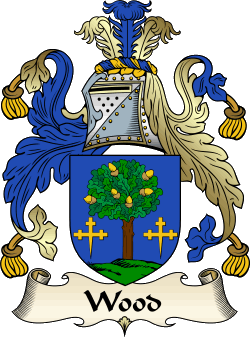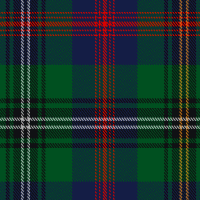Wood

Purchase Heraldry Products
Download Now!

Surname: Wood
Branch: Wood
Origins: Scottish
More Info: Scotland
|
|
Background: The erroneous notion that clans are Highland groups and families are Lowland units is very much a Victorian one. In fact, the terms are interchangeable, and many a Lowland laird has held from the Lyon Court the title ‘Chief of the Name and Arms’. This is true of the Woods.
The Old English name Wood (also Wod, Vod, Yod, Wode, Woode, Woods, Voud and other variations) may well derive from the Norman French de Vosco, or de Bosco (modern French Dubois or just Bois), meaning ‘of the wood’ (occupational names of people crafting in wood being typically Wright, Wheelwright etc., Carpenter, Arrowsmith, Carver, Cooper, Sawyer and many others). Gaelic forms incorporating ‘Coill’ also took the English translation over time. Among the Wood families that moved into southern Scotland – some say with King David I – were the Woods of Bonnytoun in Angus. They held extensive lands in that district as well as Kinkardineshire, Perthshire and elsewhere.
Admiral Sir Andrew Wood Bt., of Largo, Fife, (circa 1455 – 1521) was almost certainly a scion of that ancient clan. He was famous for inflicting many defeats on foreign pirates and privateers as well as squadrons of ships sent by the English government to harass the Scots. His successors built a hospital and school in Fife for their kinsmen named Wood, and were prominent in Scottish history both politically and militarily: they continued to be a significant influence in British politics and were foremost among the thousands of Scots who contributed enormously to the economic and armed expansion of the British Empire well into the 19th century. The main line of Sir Andrew’s descendants is considered by the Court of the Lord Lyon King of Arms to be the chiefly one. The record of succession is complete right down to 1916, when Andrew George Wood died in Mayfair, London, leaving his estate on the border of Wales and Shropshire to his second wife. He had at least two children, maybe more.
|
 Motto: Motto: Defend. Arms: Azure, an oak tree Or, growing out of a mount in base Proper, between two cross crosslets fitchee of the Second. Crest: A demi savage wreathed about the head and middle with laurel and holding erect in the dexter hand a club all Proper. Supporters: Two savages wreathed about the head and middle as in the crest, each holding a baton resting on his right shoulder. View the Heraldry Dictionary for help.

The name of Wood was previously given as 'de Bosco', a Norman name which has become common throughout New England. The name also arises as an anglicisation of several Gaelic names which incorporate the word 'coill', also meanding 'wood'. In the mid fifteenth century Andrew Wood, a merchant trader of Leith, was employed by James III to protect the Scottish trade with Holland. In 1481 he defended Dumbarton against a fleet of Edward IV of England. james III granted him lands at Largo and bestowed a knighthood upon him. When that unhappy monarch was forced to flee from his rebellious nobles, he took refuge aboard one of Sir Andrew's ships and crossed to Fife to gather an army. During the Battle of Sauchieburn, Andrew Wood's ships sailed up and down the Forth, taking on board the wounded and afterwards searched for the missing king. After the death of James III Sir Andrew refused to acknowledge the young James IV, whom he considered to be merely a pawn in the hands of his guardians. Sir Andrew was the greatest Scottish seafarer of his time, and his open contempt of the new regime went unpunished. He was entirely restored to royal favour when in 1488, and again in 1490, he defeated English fleets sent to destroy the Scottish merchant trade. James IV used Scotland's emerging naval power in his campaign to suppress the Lords of the Isles. After the fateful Battle of Flodden it was Sir Andrew Wood who was sent to France to invite the Duke of Albany to assume the regency of Scotland. Sir Andrew's grandson was one of the barons of the Parliament of 1560 who subscribed to the Articles for upholding the new reformed religion. After the downfall of Mary, Queen of Scots, he quickly joined those upholding the claims of the infant James VI.
Name Variations: Wood, Wod, Vod, Yod, Wode, Woode, Woods, Voud.
References:One or more of the following publications has been referenced for this article.The General Armory; Sir Bernard Burke - 1842.
A Handbook of Mottoes; C.N. Elvin - 1860.
Scottish Clans and Tartans; Neil Grant - 2000.
Scottish Clan and Family Encyclopedia; George Way of Plean and Romilly Squire - 1994.
Scottish Clans and Tartans; Ian Grimble - 1973.
World Tartans; Iain Zaczek - 2001.
Clans and Families of Scotland; Alexander Fulton - 1991.

|
|

The beautiful heraldry artwork for this family is available to purchase on select products from the Celtic Radio Store. We look forward to filling your order!

|
|

|

Modern |
|
|
|